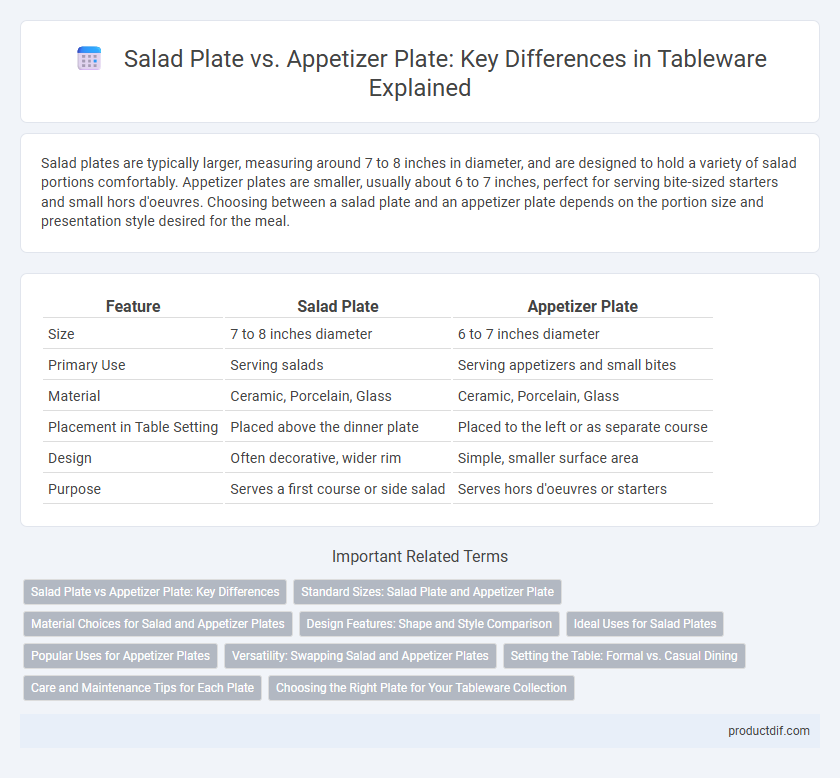Salad plates are typically larger, measuring around 7 to 8 inches in diameter, and are designed to hold a variety of salad portions comfortably. Appetizer plates are smaller, usually about 6 to 7 inches, perfect for serving bite-sized starters and small hors d'oeuvres. Choosing between a salad plate and an appetizer plate depends on the portion size and presentation style desired for the meal.
Table of Comparison
| Feature | Salad Plate | Appetizer Plate |
|---|---|---|
| Size | 7 to 8 inches diameter | 6 to 7 inches diameter |
| Primary Use | Serving salads | Serving appetizers and small bites |
| Material | Ceramic, Porcelain, Glass | Ceramic, Porcelain, Glass |
| Placement in Table Setting | Placed above the dinner plate | Placed to the left or as separate course |
| Design | Often decorative, wider rim | Simple, smaller surface area |
| Purpose | Serves a first course or side salad | Serves hors d'oeuvres or starters |
Salad Plate vs Appetizer Plate: Key Differences
Salad plates typically measure 7 to 8 inches in diameter and are designed for serving salads, allowing ample space for leafy greens and toppings. Appetizer plates are slightly smaller, around 6 to 7 inches, optimized for serving small bites and hors d'oeuvres. The key difference lies in their size and intended use: salad plates accommodate more substantial portions, whereas appetizer plates focus on smaller, more delicate servings.
Standard Sizes: Salad Plate and Appetizer Plate
Salad plates typically measure between 7 to 8 inches in diameter, designed to hold salads or small portioned side dishes. Appetizer plates are generally smaller, ranging from 5 to 7 inches, ideal for serving hors d'oeuvres or small starters. Understanding these standard sizes helps in selecting the appropriate plate for specific dining needs and table settings.
Material Choices for Salad and Appetizer Plates
Salad plates and appetizer plates commonly feature materials such as porcelain, bone china, and stoneware, prized for their durability and elegant appearance. Porcelain offers a smooth, non-porous surface ideal for preventing stains from dressings or sauces, while bone china provides a lightweight yet strong option with a translucent quality that enhances table presentation. Stoneware appeals for its rustic texture and chip-resistant properties, making it suitable for both casual and formal dining settings.
Design Features: Shape and Style Comparison
Salad plates typically feature a slightly deeper bowl shape with a gently curved rim designed to hold leafy greens and dressings securely, while appetizer plates often have a flatter surface with a broader rim to accommodate bite-sized hors d'oeuvres elegantly. The style of salad plates leans towards functionality with subtle textures or patterns that complement casual dining, whereas appetizer plates emphasize decorative elements and bold designs to enhance presentation at formal gatherings. Both plates vary in diameter, with salad plates ranging from 7 to 9 inches and appetizer plates generally measuring around 5 to 7 inches, reflecting their distinct culinary uses.
Ideal Uses for Salad Plates
Salad plates are specifically designed to hold salads, making them ideal for serving fresh greens, fruits, or light appetizers. Their slightly larger size compared to appetizer plates accommodates leafy greens without causing spills or overcrowding. These plates also complement main courses by providing a dedicated space for salads, enhancing meal presentation and portion control.
Popular Uses for Appetizer Plates
Appetizer plates, typically measuring 6 to 7 inches in diameter, are designed for serving small bites like hors d'oeuvres, finger foods, and light snacks at gatherings or cocktail parties. Their size makes them perfect for portion control and easy handling during social events, distinguishing them from larger salad plates that accommodate more substantial servings. Popular uses for appetizer plates include serving canapes, sushi, and tapas, enhancing presentation and convenience for guests.
Versatility: Swapping Salad and Appetizer Plates
Salad plates and appetizer plates are often interchangeable due to their similar sizes, typically ranging from 6 to 8 inches in diameter. This versatility allows for flexible table settings, as both plates can serve multiple purposes such as holding small salads, appetizers, or desserts. Swapping these plates streamlines dinnerware selection while maintaining an elegant presentation.
Setting the Table: Formal vs. Casual Dining
Salad plates are typically used in formal dining settings where multiple courses require distinct plates, while appetizer plates are more common in casual dining for serving small portions or starters. In a formal table setting, salad plates are often placed above the dinner plate or to the left of the forks, ensuring a clear distinction between courses. Casual settings prioritize convenience, positioning appetizer plates within easy reach for shared or individual servings.
Care and Maintenance Tips for Each Plate
Salad plates require gentle hand washing with mild detergent to preserve their delicate glaze, while dishwasher-safe appetizer plates can withstand regular machine cleaning. Avoid abrasive sponges or harsh chemicals on both types to prevent surface scratches and maintain vibrant patterns. Store plates vertically with padding to avoid chipping and ensure longevity of each piece in your tableware collection.
Choosing the Right Plate for Your Tableware Collection
Salad plates typically measure 7-8 inches in diameter and are designed for serving salads or side dishes, offering a slightly larger surface than appetizer plates which range from 5-6 inches and are perfect for bite-sized hors d'oeuvres. Choosing the right plate depends on your tableware collection's overall style and the meal courses you frequently serve; mixing sizes harmoniously enhances both functionality and presentation. Prioritize durable materials like porcelain or stoneware to ensure longevity and ease of care when selecting plates for everyday use or formal settings.
Salad Plate vs Appetizer Plate Infographic

 productdif.com
productdif.com